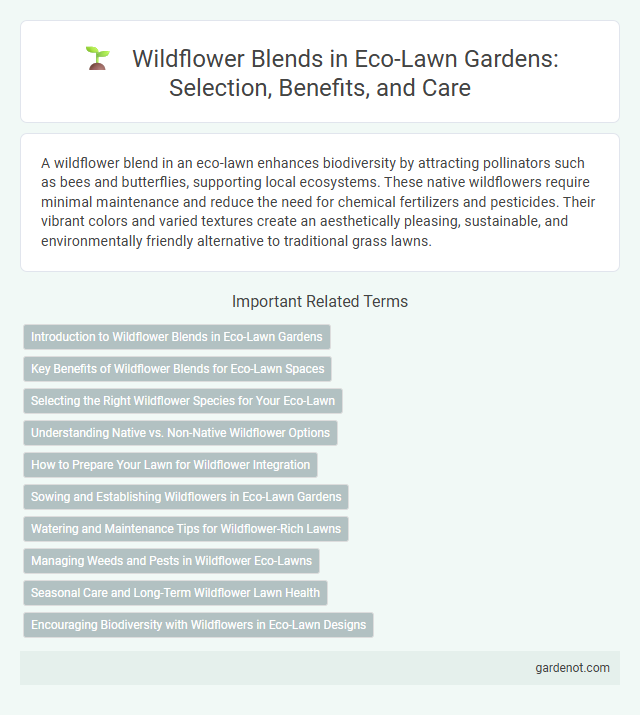A wildflower blend in an eco-lawn enhances biodiversity by attracting pollinators such as bees and butterflies, supporting local ecosystems. These native wildflowers require minimal maintenance and reduce the need for chemical fertilizers and pesticides. Their vibrant colors and varied textures create an aesthetically pleasing, sustainable, and environmentally friendly alternative to traditional grass lawns.
Introduction to Wildflower Blends in Eco-Lawn Gardens
Wildflower blends in eco-lawn gardens create vibrant, biodiverse landscapes that support local pollinators and enhance soil health. These mixes typically include native species adapted to regional climates, promoting resilience and minimal maintenance. Incorporating wildflower blends into eco-lawns increases ecological value while maintaining aesthetic appeal and sustainability.
Key Benefits of Wildflower Blends for Eco-Lawn Spaces
Wildflower blends enhance eco-lawn spaces by promoting biodiversity, attracting pollinators such as bees and butterflies, and requiring less water and maintenance than traditional grass lawns. These blends improve soil health through deep-rooted plants that reduce erosion and increase nutrient cycling. Their seasonal blooms create visually appealing landscapes that support local ecosystems and contribute to sustainable urban greening initiatives.
Selecting the Right Wildflower Species for Your Eco-Lawn
Choosing the right wildflower species for your eco-lawn involves considering local climate, soil type, and sunlight availability to ensure optimal growth and sustainability. Native wildflowers such as Black-eyed Susan, Purple Coneflower, and Blanketflower promote biodiversity and require minimal maintenance compared to non-native varieties. Integrating these species supports pollinators like bees and butterflies, enhancing the ecological value and visual appeal of your eco-lawn.
Understanding Native vs. Non-Native Wildflower Options
Wildflower blends for eco-lawns vary significantly between native and non-native species, each offering distinct ecological benefits. Native wildflowers support local pollinators and require less maintenance due to their adaptation to the regional climate and soil conditions. Non-native wildflowers may provide vibrant colors and extended blooming periods but could pose risks of invasiveness and less compatibility with local wildlife.
How to Prepare Your Lawn for Wildflower Integration
Preparing your lawn for wildflower integration requires thorough soil assessment and proper site preparation to ensure optimal growth. Begin by testing soil pH, nutrient levels, and drainage to select a wildflower blend compatible with local conditions and adjust soil amendments accordingly. Remove existing turf and weeds through scalping or herbicide application, then lightly till or rake the area to create a fine seedbed that promotes seed-to-soil contact for successful germination.
Sowing and Establishing Wildflowers in Eco-Lawn Gardens
Sowing a wildflower blend in eco-lawn gardens requires well-prepared, nutrient-poor soil to encourage native species growth and reduce aggressive grass competition. Scatter seeds evenly over the surface during early spring or late fall, followed by light raking and gentle watering to ensure optimal soil-to-seed contact and moisture retention. Establishing wildflowers involves minimal mowing, typically once or twice a year after flowering, to promote biodiversity and maintain a vibrant, sustainable eco-lawn ecosystem.
Watering and Maintenance Tips for Wildflower-Rich Lawns
Wildflower blends for eco-lawns require moderate watering, ideally during early morning or late evening to reduce evaporation and promote deep root growth. Maintaining wildflower-rich lawns involves mowing no more than twice a season at a height of 6-8 inches to allow flowers to bloom fully and reseed naturally. Avoid over-fertilizing, as nutrient-rich soils favor grass over wildflowers, reducing biodiversity and ecological benefits.
Managing Weeds and Pests in Wildflower Eco-Lawns
Wildflower eco-lawns naturally suppress weeds by promoting dense, diverse plant growth that outcompetes invasive species. Beneficial insects attracted to native wildflowers help control pests without chemical interventions, supporting a balanced ecosystem. Regular mowing and targeted weeding during establishment phases enhance plant vigor and reduce unwanted weed proliferation.
Seasonal Care and Long-Term Wildflower Lawn Health
Seasonal care for a wildflower blend eco-lawn involves targeted watering during dry spells and minimal mowing to allow flowers to bloom and reseed sustainably. Applying organic mulches in early spring supports soil moisture retention and nutrient cycling, promoting robust floral growth and soil health. Long-term wildflower lawn health depends on regular monitoring for invasive species and periodic overseeding with native wildflower seeds to maintain biodiversity and ecological balance.
Encouraging Biodiversity with Wildflowers in Eco-Lawn Designs
Wildflower blends in eco-lawn designs significantly boost biodiversity by providing native pollinators with essential nectar and pollen sources, supporting bees, butterflies, and other beneficial insects. Incorporating a diverse mix of native wildflowers enhances soil health, promotes natural pest control, and creates habitats for various wildlife species. Selecting region-specific wildflower species ensures the sustainability and ecological balance of the eco-lawn, fostering resilient and thriving green spaces.
Wildflower blend Infographic

 gardenot.com
gardenot.com